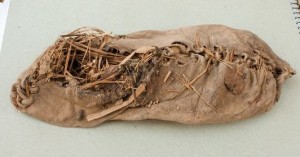
The world's oldest known leather shoe (pictured) has been found in an Armenian cave, archaeologists say. (Photograph courtesy Gregory Areshian)
Many of our patients ask us to take a look at the shoes they wear or the shoes they plan to buy to determine if they may be suitable for good foot health. There are many choices out there.
One remarkable shoe that we stumbled across in our travels (on the web) is an amazing find. While we don’t recommend wearing a cowhide stuffed with straw these days, the shoe, dated at 5500 years-old, provides insight into the human need to protect our feet with the available technology of the time.
Why do humans uniquely wear shoes? Our ability to develop technology overrides the physical limitations of our body, allowing us to adapt to environments which our body did not evolve for. Even this basic cowhide shoe, provided enough features to enable the early wearer to extend the range of their travels. Barefoot hiking, in the mountains of Armenia, where this shoe was found, is probably not good for foot health, but even this primitive shoe made it possible.
Medicine as a whole is a technological domain that has provided people with the ability to extend health and the quality of life beyond what we were innately physically endowed with. As we age, the physics of gravity and the reality of disease and age related degeneration alone present problems to a population that has an ever elongating life span. Though we are living longer, we may face mechanical dysfunction that presents itself as we age. Canes, walkers, braces, orthopedic devices and orthotics are a testament to that reality. Given that half of Americans experience some foot pain according to an APMA study, I wonder if the human foot did not evolve to have a working lifespan that matches our desire and ability to live a long time.
Podiatry is a branch of medicine that recognizes the need to maintain a quality of life and sustain the activities we wish to engage in as we age. At this practice we focus on making mechanical corrections to the impacts that aging and disease have on the foot by using technology and materials in our orthotic craft to restore a patient’s ability to do what they desire.
We have come along way from grass padding and cowhide footwear to serve our need to roam, wide and high, for as long as we can. Our innovations are state of the art for today and we hope to make a lasting contribution for the future of foot health.
Read this fascinating story of the ancient shoe told by National Geographic and let us know what you think.
Comments are closed.